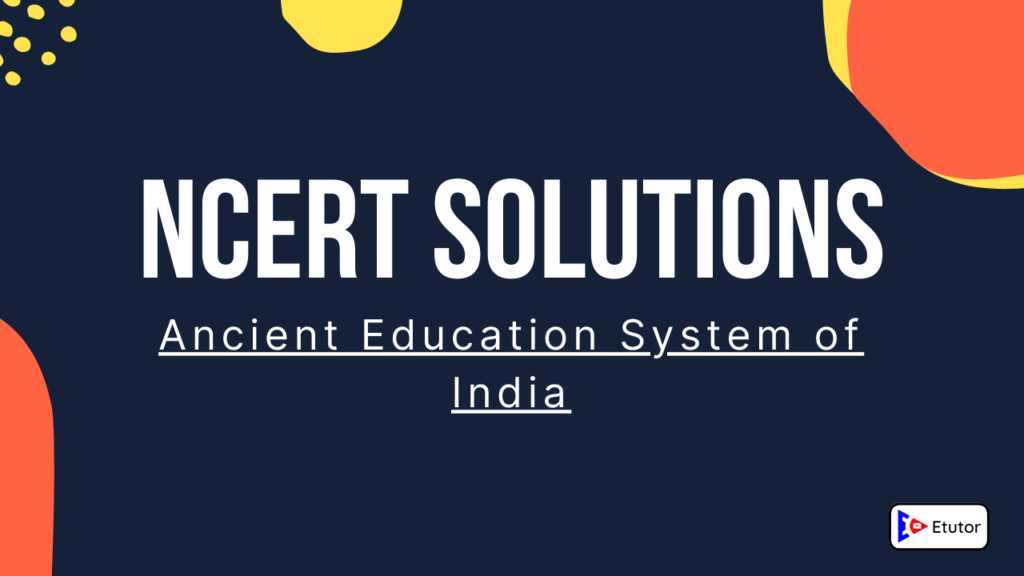Comprehension check:-
Q 1. Why were travellers attracted towards India ?
Ans. The travellers were drawn to India because it was a land of wonder to them. Indian culture, wealth, religions, philosophies, art, architecture, and educational practises were famous throughout the world. The ancient education system was regarded as a source of knowledge, traditions, and practises that guided and encouraged humanity.
Q 2. What were the sources of the ancient education system ?
Ans. The Vedas, Brahmanas, Upanishads, and Dharmasutras are all Hindu scriptures. The ancient education system was based on medical treatises written by Charaka and Sushruta.
Q 3. What were the features of education system in ancient India ?
Ans. Teaching and learning followed the tenets of the Vedas and Upanishads, fulfilling responsibilities to oneself. Family and society, thus all aspects of life are included. The educational system emphasised both learning and physical development. In other words, the emphasis was on having a healthy mind as well as a healthy body. Education in India has a history of being pragmatic, achievable, and life-enhancing.
Q 4. What was the role of guru in pupils ‘ lives ?
Ans. Teaching and learning followed the tenets of the Vedas and Upanishads, fulfilling responsibilities to oneself. Family and society, thus all aspects of life are included. The educational system emphasised both learning and physical development. In other words, the emphasis was on having a healthy mind as well as a healthy body. Education in India has a history of being pragmatic, achievable, and life-enhancing.
Comprehension Check
Q 1. Where did nuns and monks receive their education ?
Ans. Monks and nuns were educated in monasteries or viharas, which were centres of art and learning.
Q 2. What is Panini known for ?
Ans. Panini was a language and grammar expert. He is best known for his book Asthadhyayi, which is considered to be one of the greatest works on grammar.
Q 3. Which university did Xuan Zang and I – Qing study at ?
Ans.Xuan Zang and I – Qing – both attended Nalanda University.
Q 4. Which subject did Xuan Zang study in India ?
Ans. In India, Xuan Zang studied Yogashastra.
Q 5. How did society help in the education of the students ?
Ans. In some way, every member of society contributed to the cause of education. They make financial, building, and land donations.
Exercise
Discuss the following questions in small groups and write your answers .
Q 1. Which salient features of the ancient education system of India made it globally renowned ?
Ans. The ancient Indian education system was regarded as a source of knowledge, traditions, and practises that guided and encouraged humanity. This system provided body, mind, and spirit training. It aimed for an individual’s holistic development.
Q 2. Why do you think students from other countries came to India to study at that time ?
Ans. The main goal of India’s ancient education system was to have complete learning, to live a disciplined life, and to realise one’s inner potential. It aimed for an individual’s holistic development. Students from other countries came to India to study as a result of all of this.
Q 3. Why is education considered a way of life “ ?
Ans. Education is regarded as a way of life. It is the foundation of life’s moral values. It perfects man in all aspects of life. It plays the most important role in life. Life without education is no better than animal life. This is why education is regarded as a way of life.
Q 4. What do you understand by holistic education ?
Ans. Holistic education is defined as education that focuses on the moral, physical, spiritual, and intellectual aspects of life. It emphasises values such as humility, honesty, discipline, self-reliance, and respect for all living things.
Q 5. Why do you think Takshashila and Nalanda have been declared heritage sites ?
Ans. Takshashila and Nalanda were the most well-known universities in their respective eras. They were well-known for their advanced education. These universities were regarded as among the best learning institutions in the world. Both of these locations have been designated as UNESCO World Heritage Sites due to their historical significance in the field of education.





